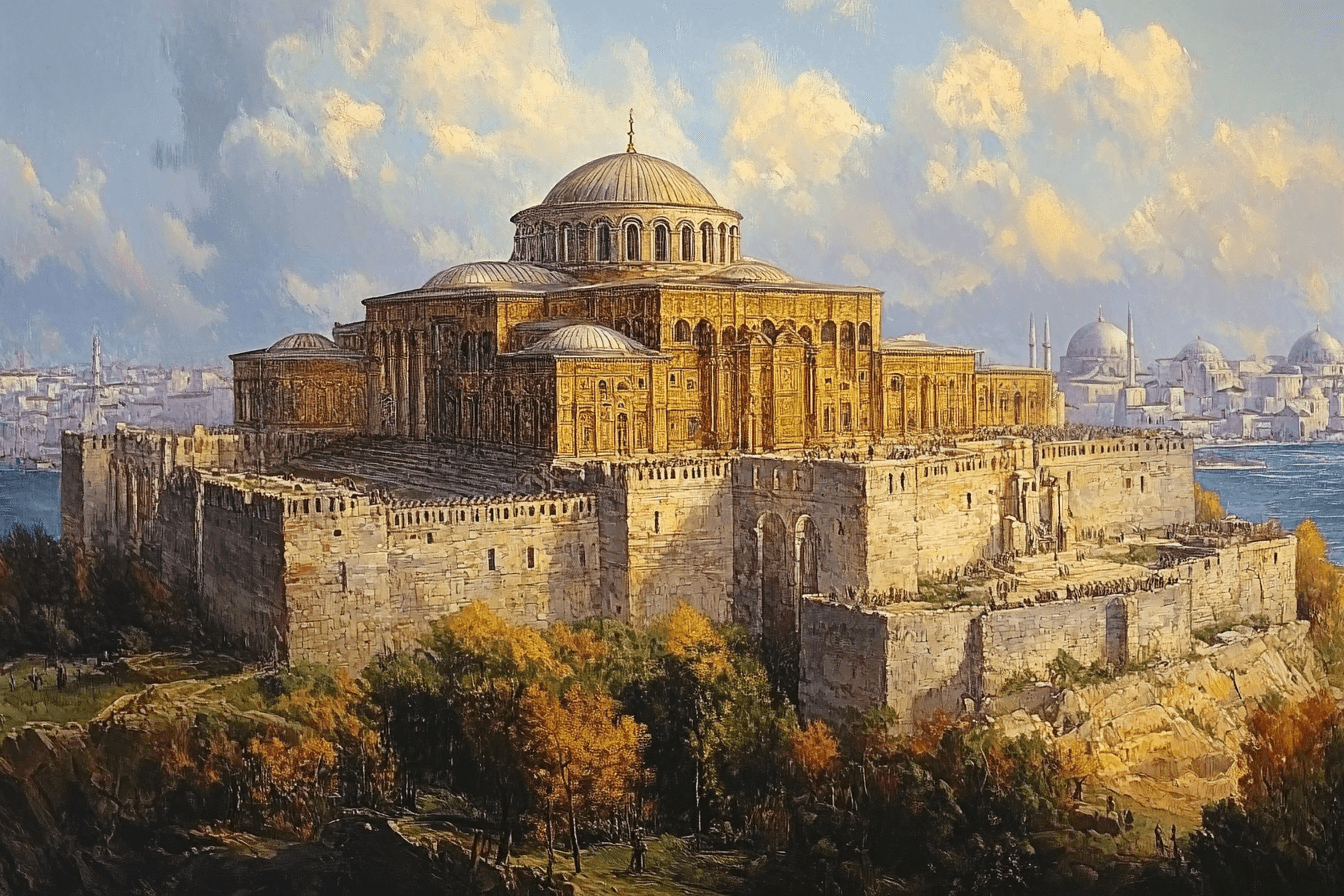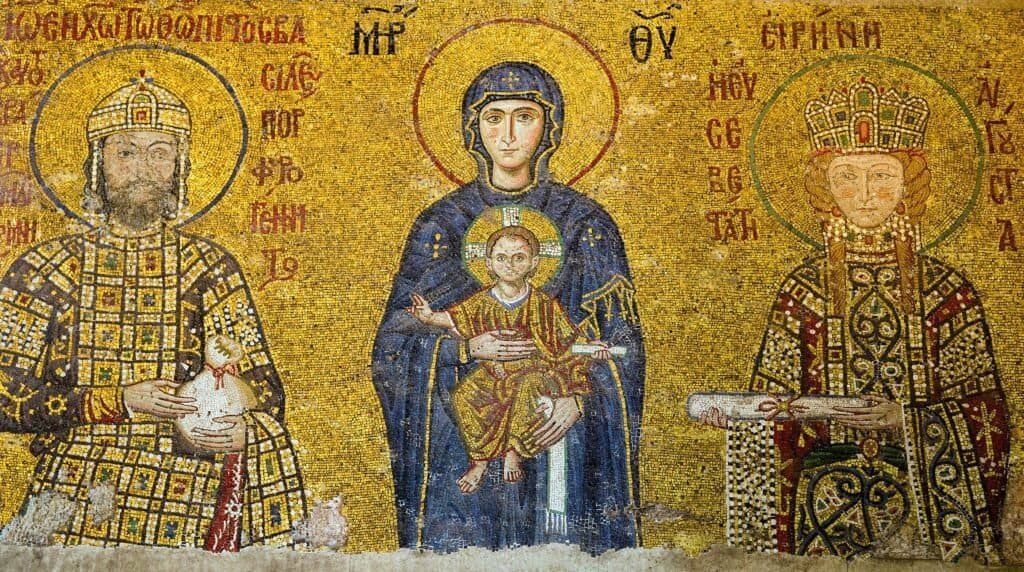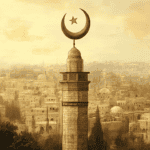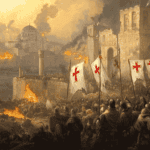
The Hagia Sophia, meaning “Holy Wisdom” in Greek, stands as one of the most iconic and historically significant structures in Istanbul, Turkey. Its rich history spans nearly 1,500 years, encompassing various religious and cultural transformations. This summary will explore the Hagia Sophia’s journey from its origins as a Christian cathedral to its current status as a mosque, highlighting key events and architectural developments along the way.
Origins and Early Structures
The history of the Hagia Sophia begins in the 4th century CE. The first church on the site was ordered to be built by Emperor Constantine I in 325 CE, on the foundations of a pagan temple. This initial structure was consecrated by Constantine’s son, Constantius II, in 360 CE. However, this wooden-roofed church was short-lived, as it was largely burnt down during riots in June 404 CE. Following the destruction of the first church, a second one was commissioned by Emperor Theodosius II. This new structure was inaugurated on October 10, 415 CE. Unfortunately, this second iteration of the Hagia Sophia also met a fiery fate. During the tumultuous Nika Revolt in January 532 CE, it was burnt to the ground, along with much of the city.
Justinian’s Grand Vision
The destruction of the second Hagia Sophia provided Emperor Justinian I with an opportunity to create a truly magnificent structure. On February 23, 532 CE, mere weeks after the Nika Revolt, Justinian ordered the construction of a new basilica that would surpass all previous iterations. ustinian enlisted the talents of two brilliant minds for this ambitious project: Anthemius of Tralles, a mathematician, and Isidorus of Miletus, a geometrician and engineer. These architects were likely influenced by the mathematical theories of Archimedes in their design.
The construction of Justinian’s Hagia Sophia was a monumental undertaking, involving 10,000 workers. The project was completed in the remarkably short time of 5 years, 10 months, and 4 days. On December 27, 537 CE, Justinian and Patriarch Menas inaugurated the new basilica with great pomp and ceremony.
Architectural Marvel

The Hagia Sophia that emerged from Justinian’s vision was a true architectural wonder. Its vast, airy central space (naos) was crowned by a massive central dome with a diameter of over 101 feet (31 meters) and a height of 160 feet (48.5 meters). This dome was often interpreted by contemporaries as representing the dome of heaven itself. The weight of the central dome was distributed through a complex system of arches, tympana, semi-domes, and arcades. This innovative structural system allowed for an unprecedented sense of open space and grandeur.
The interior was adorned with costly colored marbles, ornamental stone inlays, and decorative marble columns repurposed from ancient buildings. Initially, the upper part of the building was minimally decorated in gold, featuring a huge cross in a medallion at the summit of the dome. This relatively austere decoration would change in later centuries as more elaborate mosaics were added.
Challenges and Reconstructions
Despite its innovative design, the Hagia Sophia faced structural challenges early in its existence. The first major setback occurred in 558 CE when the central dome collapsed. This necessitated a rebuilding effort, completed in 562 CE, which resulted in the dome being reconstructed at a greater height. Over the centuries, the Hagia Sophia has endured numerous earthquakes and instances of earth subsidence. These natural forces have taken their toll on the building, requiring various repairs and reinforcements. However, it’s a testament to the skill of its original architects that the main structure standing today is essentially the same as the one built between 532 and 537 CE.
Byzantine Era

During the Byzantine period, the Hagia Sophia served as the centerpiece of religious and imperial life in Constantinople. It was the seat of the Ecumenical Patriarchate of Constantinople and played a crucial role in Byzantine imperial ceremonies, including coronations. The Hagia Sophia also functioned as a place of sanctuary, offering protection to criminals seeking asylum. However, there was debate about whether Justinian had intended for this protection to extend to murderers. The decoration of the Hagia Sophia evolved over time. After the period of Iconoclasm (726-843 CE), new figural mosaics were added to the upper parts of the building, some of which have survived to the present day.
Crusader Interlude
The Fourth Crusade in 1204 CE brought a brief but significant disruption to the Hagia Sophia’s history. During this period, the building was looted by Venetians and Crusaders. It also temporarily served as a Roman Catholic cathedral until 1261 CE when Byzantine control was restored.
Ottoman Transformation
The fall of Constantinople to the Ottoman Empire in 1453 CE marked a major turning point in the Hagia Sophia’s history. Under Sultan Mehmet II, the building was converted into a mosque, a function it would serve for nearly 500 years. This conversion brought about several changes to the structure. Minarets were added to the exterior, Christian mosaic icons were covered with whitewash, and exterior buttresses were constructed to provide additional structural support. Despite these alterations, the Ottomans largely preserved the building’s Byzantine architecture.
Modern Era
The early 20th century brought another significant change to the Hagia Sophia. In 1934, under the leadership of Mustafa Kemal Atatürk, the founder of modern Turkey, the building was secularized and converted into a museum. This decision allowed for the restoration of the building’s Christian mosaics and opened the Hagia Sophia to visitors of all faiths. In 1985, UNESCO recognized the Hagia Sophia’s immense historical and cultural value by declaring it a World Heritage Site. However, the Hagia Sophia’s status changed once again in 2020 when it was reconverted into a mosque. This decision has sparked international debate about the building’s role and the preservation of its diverse historical and cultural elements.
Architectural Significance

The Hagia Sophia’s architectural influence cannot be overstated. It is often considered the epitome of Byzantine architecture and is said to have changed the history of architecture. Its innovative use of space, light, and structural engineering set new standards for religious buildings and inspired countless structures throughout the Byzantine Empire and beyond. The central dome, in particular, represents a masterpiece of engineering for its time. Its construction pushed the boundaries of what was thought possible in architecture, creating an interior space of unprecedented openness and grandeur.
Cultural Impact
Throughout its long history, the Hagia Sophia has been more than just a building; it has been a symbol of power, faith, and cultural identity. For nearly a millennium, it stood as the largest cathedral in the world, a testament to the glory of the Byzantine Empire. Its conversion to a mosque after the Ottoman conquest symbolized the changing of eras and the shift of power in the region. The building became a model for many Ottoman mosques and continued to play a central role in the religious and cultural life of Istanbul.
In the modern era, the Hagia Sophia has become a major tourist attraction, drawing millions of visitors each year to marvel at its grand architecture and rich history. It stands as a unique monument that embodies the complex cultural heritage of Istanbul, reflecting layers of Byzantine, Ottoman, and modern Turkish history.




